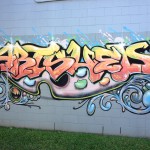
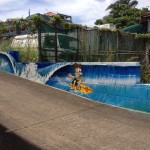
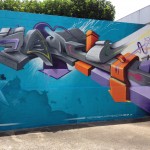
Interestingly, the image is not always associated with the business but appear to just simply brighten an otherwise plain space. I particularly like the surfer as an example of this.
]]>



Interestingly, the image is not always associated with the business but appear to just simply brighten an otherwise plain space. I particularly like the surfer as an example of this.
]]>In a recent article at Modern Kayak Fishing (formerly Yakass.net) on the “8 myths about Hobie kayaks” Josh discussed a number of issues people raise with Hobie Kayaks, including the Mirage Drives.
“Myth 8: I Can’t do That” is to do with a belief by some people that they aren’t fit enough to use the Mirage Drive.
As Josh says;
Pedalling is a lot easier than paddaling, physically and technically.
We can certainly attest to that. On our maiden voyage we pedalled 5kms into an outgoing tide. There is no way we could have paddled that distance. With the Mirage drives however we did it and while both happy to stop, we were not completely exhausted.
The other distinct advantage of the pedal based system over regular paddling is that it is alot less likely you will injure yourself. The shoulder joint is much less stable than the hip joint, which means its much more prone to injury. In addition, the thigh and butt muscles are the largest muscles in the body. Much stronger than the shoulder muscles they allow you to travel alot further with less fatigue.
All up, the Hobie Mirage Drive is an simple, elegant solution that makes going somewhere in your kayak so much more enjoyable and less exhausting. If you haven’t tried one before, take one for a test drive. You’ll be amazed at how simple it is compared to paddling.
]]>
When it first started to serve coffee last year I tried them. To be honest, it wasn’t great, and so I returned to my regular cafe for my daily caffeine hit. This year however I was enticed back when a couple of people from the office indicated that the coffee was vastly improved.
What I found was a smoother more enjoyable coffee served up with a generous dollop of humour.
So what changed?
The secret lies in the skilled baristas now working there. Liz, Marianna and Jake turn out a consistently well brewed coffee. This coupled with their knowledge of what people normally order has made all the difference.
As the trainer on the baristas course I did said, “A good barista makes or breaks a cafe”. So if you want a good coffee, roasted locally and are around West End then drop in.
]]>
According to the article on “Your Brisbane: Past and Present” this is the Gas Stripping Tower used by the South Brisbane Gas & Light Company in 1912. It’s the only one of it’s kind left in Australia and it’s job was to “purify” the coal gas by stripping out ammonia and tar.
Walking past, none of this is evident. The only signage appears to be on a small monument near the tower, but access to it, along with the tower is restricted by the relatively recent addition of the fence.
It takes a walk along the fence line a reasonable distance from the tower to find out why access is restricted. It appears that a number of the huge fig trees have Phellinus noxius, a fungus that can kill large trees. The council, rightly so, is concerned that large branches or even the trees themselves may fall unexpectedly and so access has been restricted.
What is disappointing is that none of this is obvious to the casual observer. It’s unfortunate that the Brisbane City Council hasn’t provided appropriate signage near the tower outlining the history of this unique and unusual piece of history, or the plight of the trees.
]]>
Depending on the individual, when a question arises that they don’t know the answer to, some people will resort to making something up. They may even become defensive and bluster when challenged or if additional questions occur.
I believe the correct response, and in fact the hallmark of a professional, is admitting that you don’t know and indicating you will find out. Importantly you need to then deliver on that promise.
But what about the alternative response?
Ignoring the obvious unprofessionalism of it, at some point the person will be found out. When that happens, it will call into question everything they have said, including the things they do know about.
]]>
Looking for inspiration for an appropriate cartoon image for the “Jinja Ninja” I came across the “Kitty Ninja” by Will Terrell. Will kindly granted permission for us to use our design, so the next step was finding someone to make it.
I contacted Joe from Professional Boat Stickers to turn it into a decal. Joe had a number of questions for us, including size and how we wanted to use it. He also pointed out the lines used in my initial drawing where too thin to create a long term decal. After a number iterations, we came up with the final product.
The end result looks terrific and really personalises our Tandem Island.
]]>
We were first introduced to Elios by our good friends Adrian and Janet, both of whom are big fans of the lasagne. Even after living in England for a few years, they say they have not had a better lasagne.
It took a couple of trips to Elios before we tried it ourselves. Not because we didn’t believe it was that good but because there were so many other great dishes to tempt us. When we did try it, we agreed it’s brilliant. The lasagne has a rich bolognese sauce with beautiful fresh pasta layers topped in melted cheese.
When it comes time for desert, the standout for us is their bread and butter pudding. Nothing like the bread and butter puddings of old, theirs has a wonderful blend of caramel and apple with pieces of bread that are more akin to donuts than your morning toast. It’s to die for.
To top off the wonderful food the services is fun and friendly, creating a warm and inviting atmosphere. They seem to take pride in being a bit quirky. You just have to look at the sign at the counter – “Used Ferraris and Gold Bullion Accepted” – to see this.
If all this sounds tempting, book yourself a table. Just remember to leave room for desert.
]]>Lean manufacturing, the precursor to the “Agile” methodologies, has the concept of “Stop the Line”. When a defect in the product is identified, the entire assembly line stops to locate and rectify the factors that caused the defect.
The major difference in a software development “line” is that there is no physical assembly line, so it is easy to blur the distinction between what is and isn’t part of the product and hence the “line”.
In the Lean manufacturing model it’s acknowledged that the cause of the defect may be more than just a faulty component. It may be the tools, processes or even the skills of the people involved in the manufacturing of the component that contributes to the defect. With the line stopped, the right solution can be found before production resumes.
In software development however, development continues. One of the problems Adrian points out is that
if developers keep working while the build is broken, they build up a large backlog of commits which makes it more difficult to identify which revision broke the build
It goes further than that however. By continuing to develop, the team and management are assuming that the defect was caused simply by a mistake in coding of that feature or the build process. What if the problem is in the development process, the tools or the experience of the developers involved?
Adrian goes on further to suggest that some companies go a little closer to a “Stop the line” approach by putting
an embargo on commits or close the source tree to prevent any further changes from being committed
Once again, development doesn’t stop, we simply stop putting things on the assembly line. Once the build breakage is resolved, all these potentially broken changes are pushed through.
By stopping the entire line, your development team can not only address the current defect, they can also perform a “Root Cause Analysis” of why the problem occurred, leading to better processes, tools and people.
So why do so many companies see “stopping the line” as a waste when it is the complete opposite?
I believe it’s based on a management perception that if you aren’t developing code directly related to the final product, in other words features or bug fixes, then you are not being productive. In addition, there is a belief that the number of hours spent coding directly relates to the productivity of the team. So a team is discouraged from taking the time to not only improve their tools and processes, but also to analyse what needs improving.
]]>Hobie has a solution to this, it’s called the Hobie Steering Knob. This is a small round knob you screw into the already included nut in the rudder control. This gives you something more substantial to grip when controlling the rudder, especially in strong seas.
When I bought the steering knob, Mal at Sunstate Hobie was surprised that I’d had to work the rudder so much to keep her tracking in a straight line, even with the strong winds. He suggested we check there is no slack in the line when we lock the rudder down. If there is slack it’s possible the rudder could rise slightly in fast sailing, which would then contribute to vague steering.
On our first trip since installing the knob I have to say it works great. While the winds weren’t strong, the added grip works well in giving you better control. In addition you are no longer relying on just two fingers to control the rudder.
]]>
The old man and the bird in a sack image reminded me a lot of a puzzle game I played a few years ago, Machinarium.
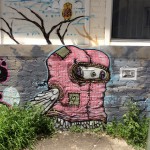
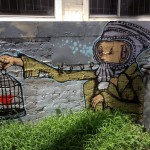
These sort of quirky images are what I find really interesting. They take a rather bland, and in this case boring grey wall and give it character and life.
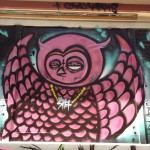
As someone said using Scrabble tiles, “Grey is the real art crime”.
]]>